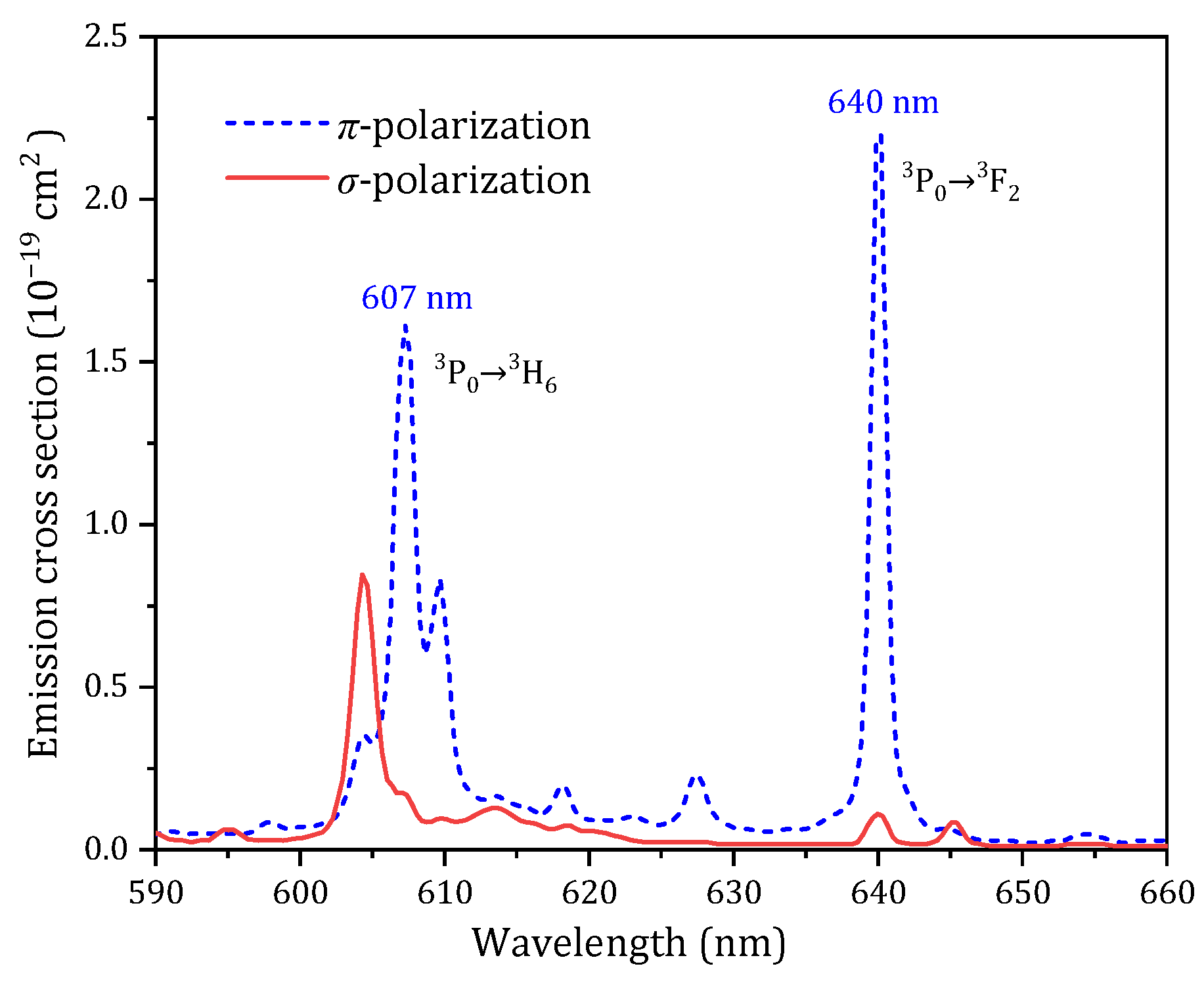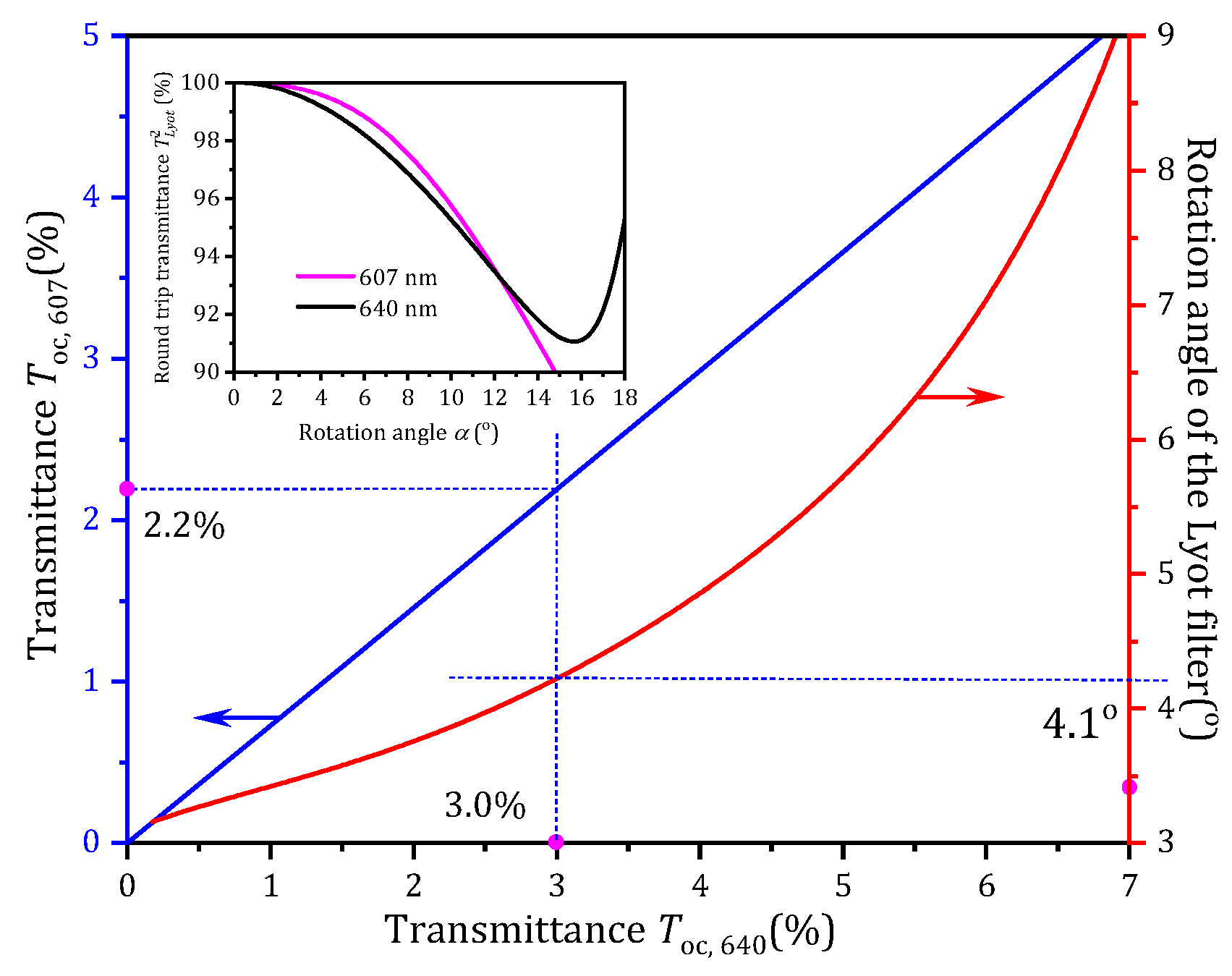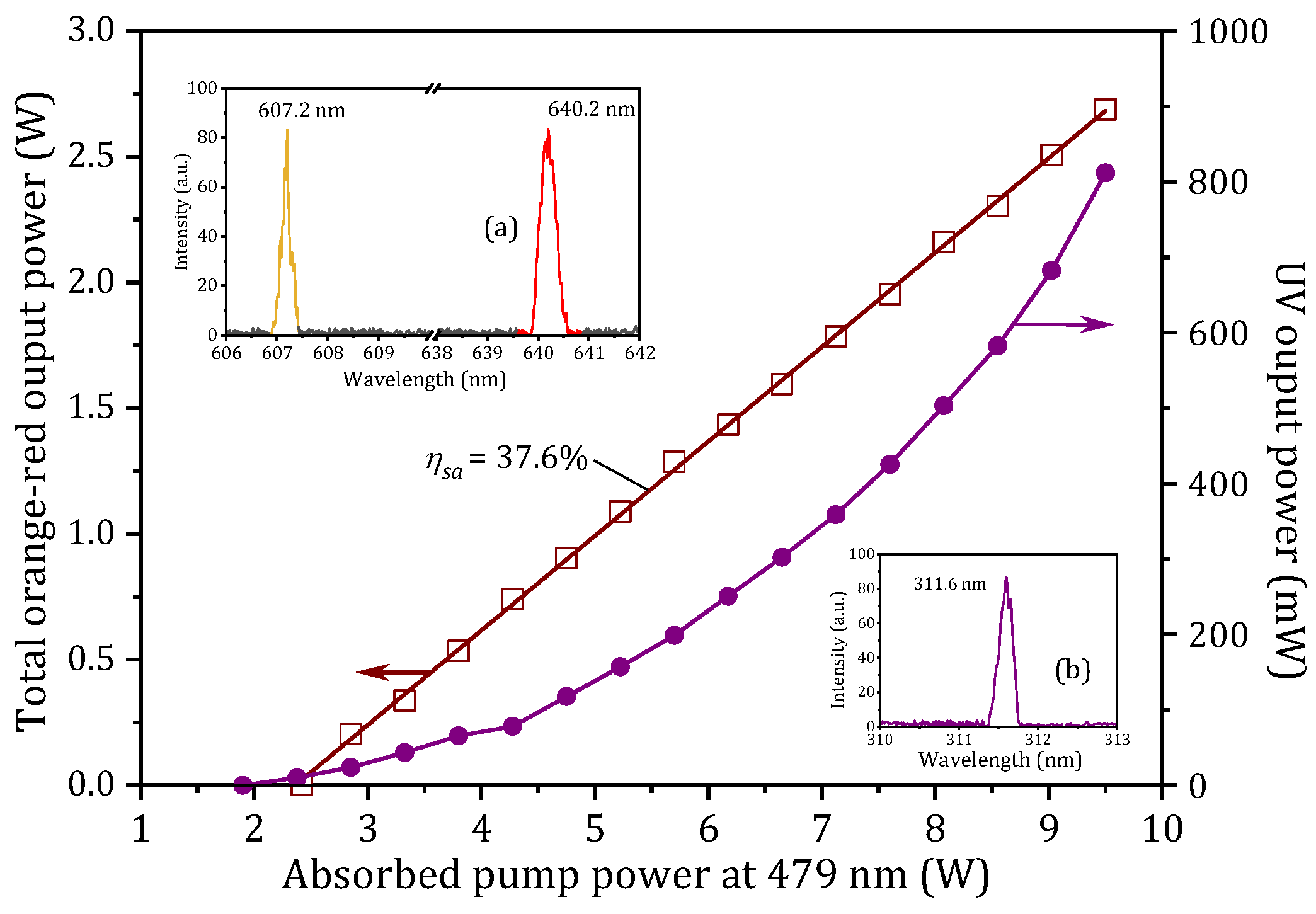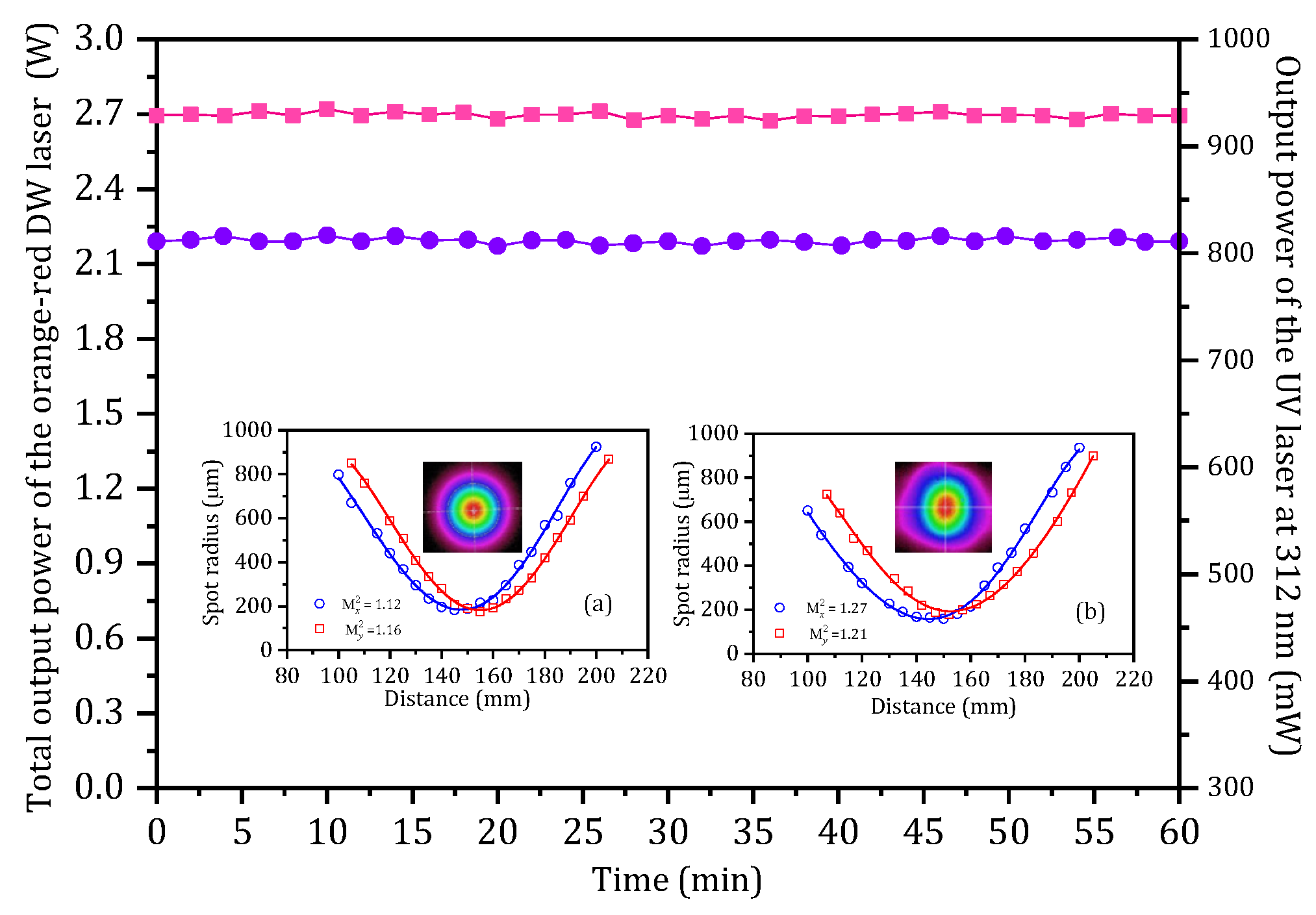Dual-Wavelength Operation at 607 nm and 640 nm with the Same Threshold and Slope Efficiency in Pr3+:LiLuF4 Crystal
Abstract
1. Introduction
2. Theoretical Analysis
3. Experimental Setup
4. Results and Discussion
5. Conclusions
Author Contributions
Funding
Institutional Review Board Statement
Informed Consent Statement
Data Availability Statement
Conflicts of Interest
References
- Gün, T.; Metz, P.; Huber, G. Power scaling of laser diode pumped Pr3+:LiYF4 cw lasers: Efficient laser operation at 522.6 nm, 545.9 nm, 607.2 nm, and 639.5 nm. Opt. Lett. 2011, 36, 1002–1004. [Google Scholar] [CrossRef] [PubMed]
- Chu, C.; Yang, X.; Wang, S.; Li, C.; Dong, Y. Diode-pumped orthogonally polarized Sm: YAP orange lasers with output power ratio and wavelength tuning. Appl. Phys. B 2025, 131, 62. [Google Scholar] [CrossRef]
- Hansen, N.; Bellancourt, A.; Weichmann, U.; Huber, G. Efficient green continuous-wave lasing of blue-diode-pumped solid-state lasers based on praseodymium-doped LiYF4. Appl. Opt. 2010, 49, 3864–3868. [Google Scholar] [CrossRef] [PubMed]
- Lin, X.; Cui, S.; Ji, S.; Tian, Q.; Zhu, Y.; Li, W.; Xu, H.; Cai, Z. LD-pumped high-power high-efficiency orange vortex Pr3+: YLF lasers. Opt. Laser. Technol. 2021, 133, 106571. [Google Scholar] [CrossRef]
- Guo, H.; Yin, M.; Zhang, W. Upconversion of Er3+ Ions in LiKGdF5: Er3+, Dy3+ Single Crystal Produced by Infrared and Green Laser. J. Rare Earth. 2006, 24, 740–744. [Google Scholar]
- Hadeethi, Y.A.; Kutbee, A.; Ahmed, M.; Sayyed, M.; Jagannath, G. Tuning of third-order nonlinear optical susceptibility of Eu3+ doped alkali borate glasses in visible region by embedding gold nanoparticles. Eur. Phys. J. Plus 2022, 137, 765. [Google Scholar] [CrossRef]
- Lin, X.; Chen, M.; Feng, Q.; Ji, S.; Cui, S.; Zhu, Y.; Xiao, B.; Li, W.; Xu, H.; Cai, Z. LD-pumped high-power CW Pr3+: YLF Laguerre-Gaussian lasers at 639 nm. Opt. Laser. Technol. 2021, 142, 107273. [Google Scholar] [CrossRef]
- Dong, J.; Jin, L.; Jin, Y.; Dong, Y.; Yu, Y.; Jin, G. Direct generation of orthogonally polarized dual-wavelength double pulse Pr: YLF visible laser. Appl. Phys. B 2024, 130, 115. [Google Scholar] [CrossRef]
- Baiocco, D.; Lopez-Quintas, I.; Vázquez de Aldana, J.R.; Tonelli, M.; Tredicucci, A. Comparative performance analysis of femtosecond-laser-written diode-pumped Pr:LiLuF4 visible waveguide lasers. Photonics 2023, 10, 377. [Google Scholar] [CrossRef]
- Xue, Y.; Dai, R.; Xu, H.; Cai, Z. High-power single-longitudinal-mode visible Pr:YLF ring lasers. Opt. Laser Technol. 2025, 180, 111495. [Google Scholar] [CrossRef]
- Zhou, S.; Pan, Y.; Li, N.; Xu, B.; Liu, J.; Song, Q.; Xu, J.; Li, D.; Liu, P.; Xu, X. Spectroscopy and diode-pumped laser operation of Pr: LaMgAl11O19 crystal. Opt. Mater. 2019, 89, 14–17. [Google Scholar] [CrossRef]
- Tian, Q.; Xu, B.; Li, N.; Luo, Z.; Xu, H.; Cai, Z. Direct generation of orthogonally polarized dual-wavelength continuous-wave and passively Q-switched vortex beam in diode-pumped Pr:YLF lasers. Opt. Lett. 2019, 44, 5586–5589. [Google Scholar] [CrossRef] [PubMed]
- Dai, W.; Jin, L.; Liu, C.; Dong, Y.; Jin, G. 13.5 μj, 20 khz repetition rate, single frequency Pr3+:YLF master oscillator power amplifier system. Photonics 2023, 10, 903. [Google Scholar] [CrossRef]
- Zhang, S.; Wang, S.; Lian, G.; Wang, Z.; Yu, H.; Zhang, H. 7.56-W continuous-wave Pr3+-based green laser via managing thermally induced effects. Opt. Express 2024, 32, 959–968. [Google Scholar] [CrossRef]
- Lin, X.; Ji, S.; Feng, Q.; Liu, X.; Fang, R.; Xiao, B.; Li, W.; Xu, H.; Cai, Z. Heat-induced wavelength-switchable high-power CW orange Pr3+:YLF lasers. J. Lumin. 2022, 243, 118627. [Google Scholar] [CrossRef]
- Jin, L.; Jin, Y.; Yu, Y.; Dong, Y.; Jin, G. Orthogonally polarized dual-wavelength single longitudinal mode Pr:YLF laser at 607 nm and 604 nm. Opt. Commun. 2023, 530, 129180. [Google Scholar] [CrossRef]
- Huang, H.; Xia, J.; Anh, N.; Li, Y.; Zhang, Y.; Zhang, Q.; Zhao, Z.; Lü, Y. Orthogonally Polarized Dual-Wavelength Pr:LLF Green Laser at 546 nm and 550 nm with the Balanced Output Powers at All Pump Power Level. Photonics 2025, 12, 393. [Google Scholar] [CrossRef]
- Xia, J.; Lü, Y.; Liu, H.; Pu, X. Diode-pumped Pr3+:LiYF4 visible dual-wavelength laser. Opt. Commun. 2015, 334, 160–163. [Google Scholar] [CrossRef]
- Kaneda, Y.; Tanaka, H.; Temyanko, V. Diode-pumped Sm:YLF laser at 605 nm and 648 nm. Opt. Express 2025, 33, 8903–8910. [Google Scholar] [CrossRef]
- Huang, Y.; Cho, C.; Huang, Y.; Chen, Y. Orthogonally polarized dual-wavelength Nd: LuVO4 laser at 1086 nm and 1089 nm. Opt. Express 2012, 20, 5644–5651. [Google Scholar] [CrossRef]
- Du, E.; Zheng, H.; He, H.; Li, S.; Qiu, C.; Zhang, W.; Wang, G.; Li, X.; Ma, L.; Shen, S.; et al. Dual-wavelength confocal laser speckle contrast imaging using a deep learning approach. Photonics 2024, 11, 1085. [Google Scholar] [CrossRef]
- Wang, S.; Li, C.; Li, Y.; Xia, J. Orthogonally polarized dual-wavelength Nd:LiYF4 laser at 903 and 908 nm on 4F3/2→4I9/2 transition. Opt. Laser Technol. 2025, 180, 111510. [Google Scholar] [CrossRef]
- Huang, H.; Li, Y.; Zhang, Y.; Zhang, Q.; Wang, S.; Li, C.; Dong, Y.; Xia, J. Research on output power ratio of dual-wavelength Nd:NaLa(WO4)2 laser on 4F3/2→4I13/2 transition. Opt. Laser Technol. 2025, 181, 112043. [Google Scholar] [CrossRef]
- Waritanant, T.; Major, A. Dual-wavelength operation of a diode-pumped Nd:YVO4 laser at the 1064.1 & 1073.1 nm and 1064.1 & 1085.3 nm wavelength pairs. Appl. Phys. B 2018, 124, 87. [Google Scholar]
- Zheng, Y.; Zhong, K.; Qiao, H.; Zhang, X.; Li, F.; Sun, Y.; Wang, S.; Xu, D.; Yao, J. Compact, efficient and power-ratio tunable orthogonally polarized Nd:YVO4 laser with coaxial diode-end-pumping configuration. Opt. Commun. 2022, 523, 128739. [Google Scholar] [CrossRef]
- Lin, H.; Bao, S.; Liu, X.; Song, S.; Wen, Z.; Sun, D. Dual-wavelength continuous-wave and passively q-switched alexandrite laser at 736.7 nm and 752.8 nm. Photonics 2022, 9, 769. [Google Scholar] [CrossRef]
- Liu, Y.; Zhong, K.; Mei, J.; Liu, C.; Shi, J.; Ding, X.; Xu, D.; Shi, W.; Yao, J. Compact and stable high-repetition-rate terahertz generation based on an efficient coaxially pumped dual-wavelength laser. Opt. Express 2017, 25, 31988–31996. [Google Scholar] [CrossRef]
- Huber, G.; Krühler, W.; Bludau, W.; Danielmeyer, H. Anisotropy in the laser performance of NdP5O14. J. Appl. Phys. 1975, 46, 3580–3584. [Google Scholar] [CrossRef]
- Cornacchia, F.; Richter, A.; Heumann, E.; Huber, G.; Parisi, D.; Tonelli, M. Visible laser emission of solid state pumped LiLuF4:Pr3+. Opt. Express 2007, 15, 992–1002. [Google Scholar] [CrossRef]
- Ivanova, I.; Morozov, A.; Petrova, M.; Podkolzina, I.; Feofilov, P. Preparation and properties of single crystals of double fluorides of lithium and the rare earths. Inorg. Mater. 1975, 11, 1868. [Google Scholar]
- Cornacchia, F.; Toncelli, A.; Tonelli, M. 2 μm Lasers with fluoride crystals: Research and development. Prog. Quantum Electron. 2009, 33, 61–109. [Google Scholar] [CrossRef]
- Chen, X.; Shao, Y.; Yuan, J.; Zhang, D.; Wang, A. 303.5 nm cw Pr:BYF–BBO laser emission under 447 nm all-solid-state Nd:GdVO4–BiBO blue laser pumping. Laser Phys. Lett. 2013, 10, 065002. [Google Scholar] [CrossRef]
- Han, Y.; Guo, K.; Zhao, Y.; Xiong, M.; Wang, D.; Chen, J.; Cui, X.; Xu, B. Compact high-power 320-nm continuous-wave single-frequency laser based on power scaling of a diode-pumped Pr:LiYF4 ring laser at red. Opt. Lett. 2024, 49, 3854–3857. [Google Scholar] [CrossRef]
- Koechner, W. Solid-State Laser Engineering; Springer: Heidelberg, Germany, 2006. [Google Scholar]
- Lü, Y.; Zhang, J.; Xia, J.; Liu, H. Diode-Pumped Quasi-Three-Level Nd:YVO4 Laser with Orthogonally Polarized Emission. IEEE Photon. Technol. Lett. 2014, 26, 656–659. [Google Scholar] [CrossRef]
- Li, P.; Li, D.; Li, C.; Zhang, Z. Simultaneous dual-wavelength continuous wave laser operation at 1.06 μm and 946 nm in Nd:YAG and their frequency doubling. Opt. Commun. 2004, 235, 169–174. [Google Scholar] [CrossRef]
- Lünstedt, K.; Pavel, N.; Petermann, K.; Huber, G. Continuous-wave simultaneous dual-wavelength operation at 912 nm and 1063 nm in Nd:GdVO4. Appl. Phys. B 2007, 86, 65–70. [Google Scholar] [CrossRef]
- Wang, X.; Yao, J. Transmitted and tuning characteristics of birefringent filters. Appl. Opt. 1992, 31, 450–4507. [Google Scholar] [CrossRef]
- Fan, T.; Byer, R. Diode laser-pumped solid-state lasers. IEEE J. Quantum Electron. 1988, QE-24, 895–912. [Google Scholar] [CrossRef]
- Chen, Y. cw dual-wavelength operation of a diode-pumped Nd:YVO4 laser. Appl. Phys. B 2000, 70, 475–478. [Google Scholar] [CrossRef]
- Zheng, Y.; Zhong, K.; Liu, K.; Qiao, H.; Zhang, X.; Xu, D.; Yao, J. Thermal effects of diode-end-pumped dual-wavelength solid-state lasers with coaxially arranged dual laser crystals. In Advanced Lasers, High-Power Lasers, and Applications XII; SPIE: Paris, France, 2021; pp. 51–61. [Google Scholar]







Disclaimer/Publisher’s Note: The statements, opinions and data contained in all publications are solely those of the individual author(s) and contributor(s) and not of MDPI and/or the editor(s). MDPI and/or the editor(s) disclaim responsibility for any injury to people or property resulting from any ideas, methods, instructions or products referred to in the content. |
© 2025 by the authors. Licensee MDPI, Basel, Switzerland. This article is an open access article distributed under the terms and conditions of the Creative Commons Attribution (CC BY) license (https://creativecommons.org/licenses/by/4.0/).
Share and Cite
Huang, H.; Xia, J.; Anh, N.; Li, Y.; Lü, Y. Dual-Wavelength Operation at 607 nm and 640 nm with the Same Threshold and Slope Efficiency in Pr3+:LiLuF4 Crystal. Photonics 2025, 12, 447. https://doi.org/10.3390/photonics12050447
Huang H, Xia J, Anh N, Li Y, Lü Y. Dual-Wavelength Operation at 607 nm and 640 nm with the Same Threshold and Slope Efficiency in Pr3+:LiLuF4 Crystal. Photonics. 2025; 12(5):447. https://doi.org/10.3390/photonics12050447
Chicago/Turabian StyleHuang, Haotian, Jing Xia, Nguyentuan Anh, Yuzhao Li, and Yanfei Lü. 2025. "Dual-Wavelength Operation at 607 nm and 640 nm with the Same Threshold and Slope Efficiency in Pr3+:LiLuF4 Crystal" Photonics 12, no. 5: 447. https://doi.org/10.3390/photonics12050447
APA StyleHuang, H., Xia, J., Anh, N., Li, Y., & Lü, Y. (2025). Dual-Wavelength Operation at 607 nm and 640 nm with the Same Threshold and Slope Efficiency in Pr3+:LiLuF4 Crystal. Photonics, 12(5), 447. https://doi.org/10.3390/photonics12050447




